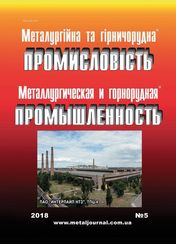Billet СС’s moulds heat engineering parameters monitoring system |
\\ Статьи
System for billet continuous caster’s mould heat engineering parameters monitoring based on APCS standard gauges set signals profound interpretation is created. This system allows maintaining change in time of such important parameters that characterize mould heat work as average heat flux density, average overall heat exchange coefficient in the mould, average heat transfer coefficient to mould inner surface, effective gas gap thickness. It is proved that effective gas gap thickness control in real time makes possible operative mould inner surface wearing control, practical check of mould taper and billet shrinking correspondence, choice of better moulds for concrete industrial conditions, learning dependence of mould wearing and billet’s form defects formation.
Key words: billet, continuous caster’s mould, heat dissipater, mould wearing, effective gas gap thickness

Alexei Birukov
Doctor of Science, docent of technical thermophysics department,
Donetsk National Technical University
Billet СС’s moulds heat engineering parameters monitoring system
Problem and its connection with scientific and practical tasks
Reliable operation of continuous casting machine and the quality of sections depend greatly on continuous casting machine heat parameters. That is why researches and developments focused on the advance of heat engineering parameters of all continuous casting machine elements are essential. Significant role in support of reasonable characteristics of working continuous casting machines plays Automatic process control systems (APCS), which integrate constantly and in prospect should carry the function of full control and rapid analysis of all the continuous casting machine parameters.
Evaluation of publications concerning the topic of research
Generally accepted fact about the direct dependence of billets quality and casting process reliability on accuracy of the continuous casting processes, thermal first of all [1]. Probably, nowadays all the continuous casting machines are fitted with such monitoring levels as differential temperature of cooling water in continuous caster’s mould [1-3]. It contains the indirect information about heat amount transferred in the mould, that in its turn characterize heat-exchange between ingot shell and inner face of the mould. The increase of cooling water differential temperatures in the continuous caster’s mouldindicates the increase of heat amount, taken off from the billet surface and vice versa [3].
But this value does not allow to intercompare mould work of both different continuous casting machines and one and the same aggregate, but in various periods of time as the variations between differential temperatures could be caused by some changes in costs for continuous caster’s mould primary cooling water [4].
Research problem statement
Aim of the given research is developing of scientific bases of heat engineering parameters control system for billet СС’s moulds, based on the typical detector signals of APCS advanced interpretation and allowing to get the information, upon which the comparison of thermal performance of different moulds and their reasonable design factors and operational parameters specification are possible.
Presentation of material and results
In continuous caster’s mouldthe heat from melted steel is transferred to cooling water through the placed in series range of thermal resistances [5] (fig.1).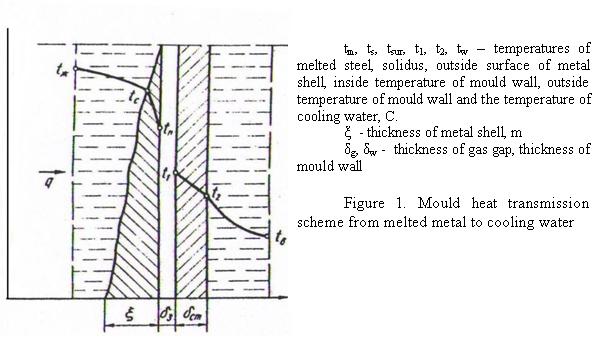
For the adequate comparison of moulds thermal performance can be used the values not depending on primary water flow. In the role of such values it makes sense to use heat flow average density from the surface of billet in the mould (![]() ), heat-transfer coefficient average value in the mould (
), heat-transfer coefficient average value in the mould (![]() ), average ratio of heat transfer from billet shell to inner surface of the mould tube (
), average ratio of heat transfer from billet shell to inner surface of the mould tube (![]() ), effective gas gap thickness (deff). Methodology of these values determination is given below.
), effective gas gap thickness (deff). Methodology of these values determination is given below.
The value of average density may be determined from the equation of the mould average temperature balance:
![]() , (1)
, (1)
where G – bulk water flow through the mould, kg/sec;
c – water heating capacity J/(kg×Cal);
Dt - differential temperature of cooling water in the mould, C;
F – the billet and mould contact surface, м2
According to the heat-transfer law the average density of heat flow mat be expressed as
![]() , (2)
, (2)
where ts - solidus temperature for pouring steel grade, C;
twav – average temperature of cooling water in the mould.
As in the function of heat transmission moving force in the expression (2) the differential temperature from solidus to the average temperature of cooling water is taken, ![]() value acts as “conduction” of thermal chain, including thermal resistance to heat transferring through solid shell, gas gap, mould liner wall and from its outside surface to cooling water.
value acts as “conduction” of thermal chain, including thermal resistance to heat transferring through solid shell, gas gap, mould liner wall and from its outside surface to cooling water.
Having determined the average density of heat flow from the billet surface in the mould, one can find the average value of heat-transfer coefficient in the mould from the heat-balance equation:
 .
.
Using with some dependence allowances, true for steady-state heat transfer, one may state the dependence of heat transmission average ratio in the mould on all the thermal resistances
 , (3)
, (3)
where aw - heat-transfer coefficient from the outer surface of the mould tube to the water (W/m2×Cal);
dm – mould tube wall thickness, m;
lm - thermal conductivity of the mould tube material, (W/m×Cal);
![]() - the average thickness of metal shell in the mould, m;
- the average thickness of metal shell in the mould, m;
lsh - heat conduction coefficient of the billet shell at its integral temperature, (W/m×Cal).
With the help of equation (3) one can calculate the average heat transfer coefficient from billet shell to inner surface of mould tube:
 . (4)
. (4)
This value contains integrated information about thermal-mechanical processes proceeding in the mould. The analysis of its values for moulds of different degrees of taper allows to specify the concept of heat exchange in the mould. As the value ![]() is known, it is possible to determine the value of effective thickness of gas gap between billet shell and the inner surface of mould tube (deff). Once while usage of gas gap effective thickness value for studying of heat exchange in the mould is supposed that heat flow from the billet surface is formed according to two mechanisms: radiating and heat conduction through a gas gap, than we have the following formula:
is known, it is possible to determine the value of effective thickness of gas gap between billet shell and the inner surface of mould tube (deff). Once while usage of gas gap effective thickness value for studying of heat exchange in the mould is supposed that heat flow from the billet surface is formed according to two mechanisms: radiating and heat conduction through a gas gap, than we have the following formula:
![]() , (5)
, (5)
where ![]() - gas space heat conduction, W/(m∙Cal);
- gas space heat conduction, W/(m∙Cal);
ar - radiation coefficient from the billet shell to inner surface of mould tube, W/(m2×Cal).
The ar value is calculated on the basis of the known dependence describing radiant heat exchange:
 , (6)
, (6)
where Ts - temperature of the billet surface, K;
Тst– temperature of the inner mould tube surface, K (temperature of steel);
Cg – the given coefficient of radiating while radiant heat exchange between billet surface and inner mould tube surface.
The values Тs and Тst can be determined with rather small accuracy on the basis of dependences that are true for steady-state heat transfer through the range of placed in series thermal resistances:
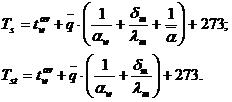 (7)
(7)
One may conclude that on the basis of analysis of the given dependences (1-7) under APCS in real-time mode the changes of all values (![]() ,
, ![]() ,
, ![]() , deff) may be determined, depending on such parameters as differential temperature of cooling water in the mould, usage of primary water, thermal and physical characteristics of the poured steel, geometrical parameters of the mould tube (Figure2).
, deff) may be determined, depending on such parameters as differential temperature of cooling water in the mould, usage of primary water, thermal and physical characteristics of the poured steel, geometrical parameters of the mould tube (Figure2).
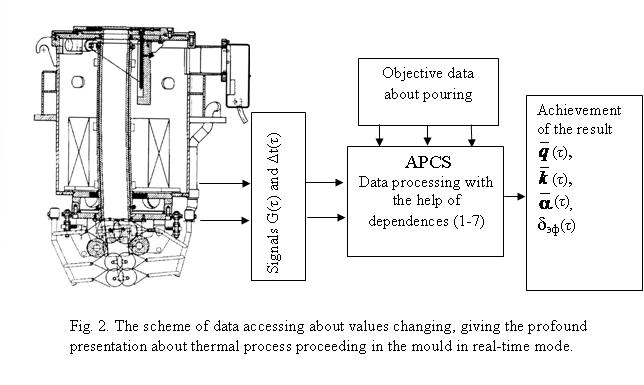
The example of determination of dependence effective thickness of gas gap on the differential temperature of cooling water in the mould with the help of proposed calculated dependences for the following initial data ( billet 130х130 mm, usage of primary water 30kg/s, mould tube material is copper, mould tube wall thickness 0,01 m) is given in the fig. 3.
Monitoring of value of gas gap effective thickness in real-time mode with the help of APCS allows the following:
- operational control of mould tube interface wear on the basis of changing analysis at time of the value deff;
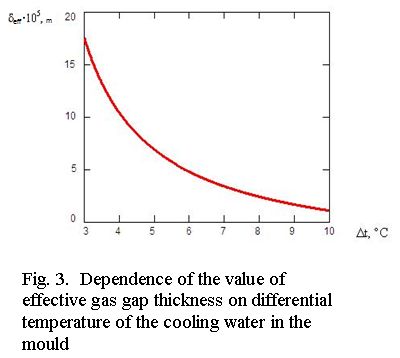 - practical checking of correspondence of mould degree of taper to the billet shrinking-off on the basis of average level comparison deff for concrete combinations of the mould sections and steel grades with optimal values of gas gap effective thickness, determined while practical studies;
- practical checking of correspondence of mould degree of taper to the billet shrinking-off on the basis of average level comparison deff for concrete combinations of the mould sections and steel grades with optimal values of gas gap effective thickness, determined while practical studies;
- choice of the best moulds for the concrete manufacturing conditions on the basis of analysis of corresponding data files about average value of effective gas gap wall thickness;
- estimating of relationships between mould tube wear and defect formation of rhombic form. It is achieved by cooperative data processing about heat and speed rates of steel pouring, grades of steel, moulds taper, corresponding them effective gas gap thickness and data on the billet of rhombic form with the help of mathematical statistics device.
Conclusions and the follow-up study perspective view
In this work the billet СС’s moulds heat engineering parameters monitoring system is created, based on the deepened interpretation of typical detector signals of APCSdue to their usage as argument in specifically developed dependences.
The given system fixes change in parameters time, which allows to compare the values of thermal performance of different moulds and estimate the operational efficiency: the average density of heat flow, the average coefficients of heat transmission in the mould and heat transmission to the inner surface of the mould, effective gas gap thickness.
It is shown that control of the effective gas gap thickness value in real-time mode makes it possible to monitor the wear of mould tube inner surface, checking of the correspondence of mould taper to the billet shrinking-off , choice of the best moulds for concrete manufacturing conditions, estimating relationships between mould tubes wear and defect formation of rhombic form.
The significant trend of follow-up studies is the creation of methodology allowing to predict dissymmetric features of the inner surface tube mould wear on the basis of APCS, averaged for the whole mould tube surface values of heat-flow rate and effective gas gap thickness.
References
Birukov, A.B. The modern aspects of CC machine heat monitoring (2008). Metal and casting of Ukraine, 37-40.
Djudkin, D.A. The quality of continuously cast steel workpiece (1988). Technique, 253.
Emel’yanov, V.A. Thermal performance of CC machine: teaching aid for HEIs V.A. (1988). Metallurgy, 143.
Smirnov, A.N., Smirnov, Kuberskii, S.V., Podkorytov, A.L. Continuous casting of billet. (2012). 417.
Smirnov, A.N., Kuberskii, S.V., Shtepan, E.V. Continuous steel casting (2001). DonNTU, 482.

